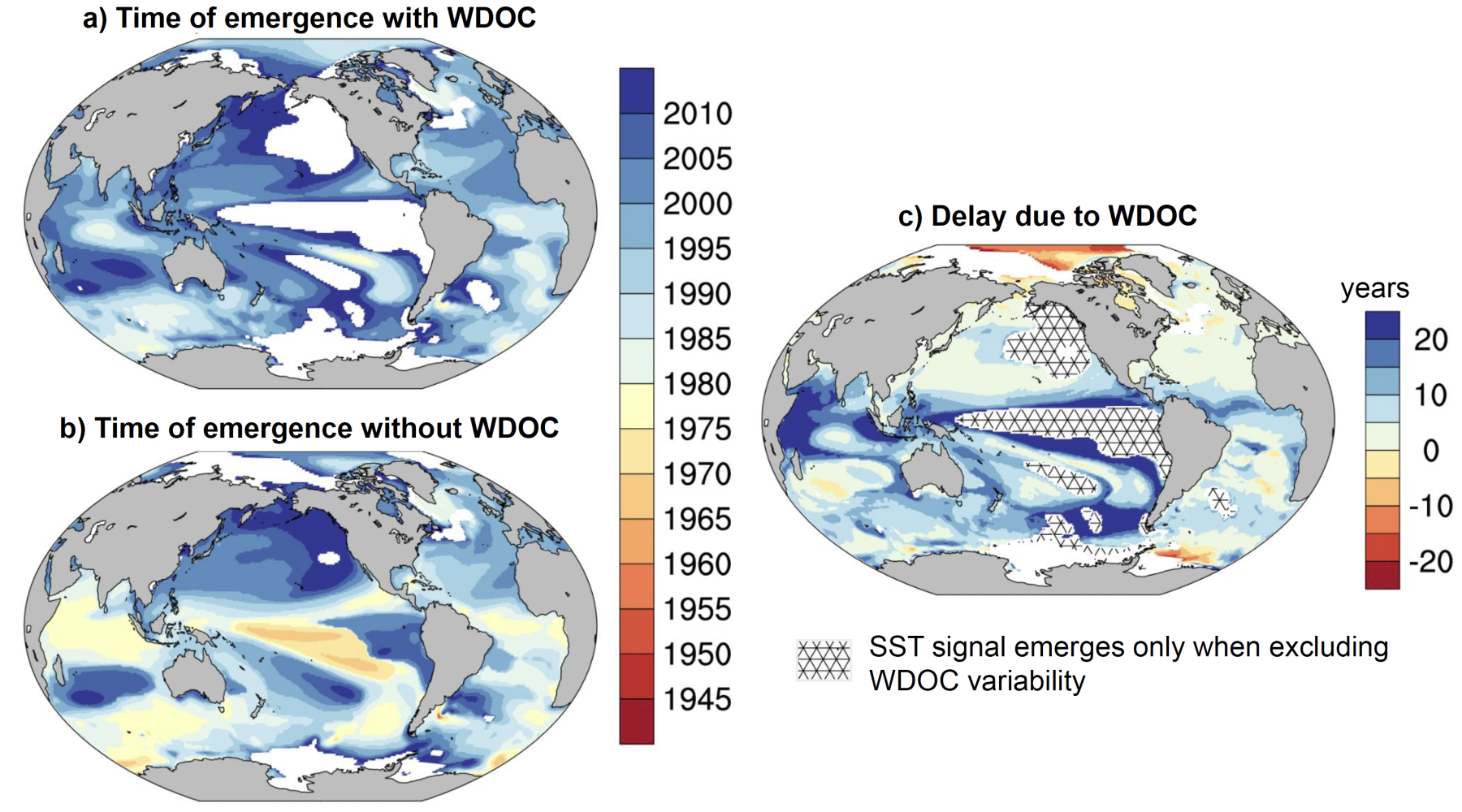Ocean dynamics delay emergence of SST warming signals
Warming sea surface temperatures (SSTs) have been observed in many regions, with impacts on atmospheric circulation, tropical precipitation, and marine ecosystems. To robustly link these trends to climate change requires that the trend is larger than natural (or internal) variability in SSTs in the same location. If trends are not yet detectable, climate models can inform when the trends are likely to emerge. This concept, referred to as “time of emergence,” depends both on the magnitude of the trend and on the amplitude of internal variability. Over the next several decades, internal variability is expected to be the largest source of uncertainty in time of emergence of SST trends.
The strongest internal SST variability that may mask anthropogenic SST signals occurs where internal wind-driven ocean circulation (WDOC) variability contributes heavily to SST changes. These regions include the tropical equatorial Pacific, home to El Niño-Southern Oscillation, upwelling regions, and western boundary current regions. Larson and McMonigal (2025) analyze two climate model ensemble experiments, one with internal WDOC variability and one without, to determine how much ocean circulation variability impacts when anthropogenic SST signals emerge. They find that overall, internal WDOC variability delays the time of emergence of anthropogenic SST signals everywhere, with the longest delays occurring in the global tropics and other dynamically active regions of the ocean (Figure 1).

Figure 1. Time of emergence of externally forced SST signals over the historical period 1900-2014 in the CESM2 climate model as estimated (a) with wind driven ocean circulation (WDOC) variability and (b) without WDOC variability. (c) The delay in time of emergence due to WDOC is defined as (a) minus (b). White shading in (a, b) shows where emergence does not occur. Hatching in (c) indicates where emergence does not occur in (a) but does occur in (b), indicating that the WDOC delays the time of emergence, but the number of years cannot be computed. Adapted from Figure 4 in Larson and McMonigal (2025).
Another important consideration in climate change studies is that the characteristics, including the amplitude, of internal SST variability may change as the mean climate state evolves. This factor could also impact the time of emergence of SST signals. For example, if the vertical temperature distribution of the ocean changes as the climate warms, the efficiency of cold water upwelling may change, thus impacting the amplitude of SST variations. Larson and McMonigal (2025) find that the amplitude of internal SST variability changes significantly over the historical period across the global ocean when WDOC variability is included but is generally unchanged when WDOC variability is excluded. Their result suggests that regions where SST variations are heavily driven by ocean dynamics may see the largest changes in internal variability in the future.
This study argues that the time of emergence of anthropogenic SST signals in models may be highly dependent on the individual model’s internal wind-driven ocean dynamics. When estimating the time of emergence of SST trends, inter-model differences in wind-driven ocean dynamics may be just as important as different model responses to anthropogenic forcing.
Internal Wind Driven Ocean Circulation Variability Delays the Time of Emergence of Externally Forced Sea Surface Temperature Trends (Geophysical Research Letters)
Topics
- Ocean Heat
